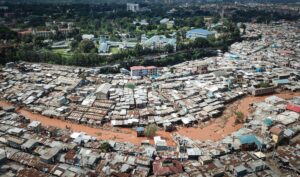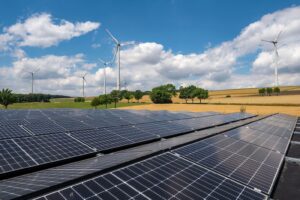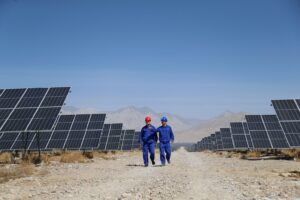The highest court of the UN has issued a landmark “advisory opinion” stating that nations can be held legally accountable for their greenhouse-gas emissions.
Recognising the “urgent and existential threat” facing the world, the International Court of Justice (ICJ) concluded that those harmed by human-caused climate change are entitled to “reparations”.
Their opinion largely rests on the application of existing international law, clarifying that climate “harms” can be clearly linked to major emitters and fossil-fuel producers.
The case, which was triggered by a group of Pacific island students and championed by the government of Vanuatu, saw unprecedented levels of input from nations.
In a unanimous decision issued on 23 July, the 15 judges on the ICJ concluded that the production and consumption of fossil fuels “may constitute an internationally wrongful act attributable to that state”.
The opinion also says that limiting global warming to 1.5C should be considered the “primary temperature goal” for nations and, to achieve it, they are obliged to make “adequate contributions”.
While the ICJ opinion is not binding for governments, it is expected to have a significant impact as vulnerable groups and nations fight for climate compensation in court.
Below, Carbon Brief explains the most important aspects of the ICJ’s 133-page advisory opinion and speaks to legal experts about its implications.
- How did this case come about?
- How has the case been decided?
- What does the ICJ say about climate science?
- What does the ICJ say about countries’ climate obligations?
- What does it say about the legal consequences of breaches?
- What does it say about historical responsibility and reparations?
- What does it say about the Paris Agreement and 1.5C?
- What does it say about fossil fuels?
How did this case come about?
The case stems from a campaign led by 27 students from the University of the South Pacific in Fiji.
In 2019, they established a youth-led grassroots organisation – dubbed the Pacific Island Students Fighting Climate Change (PISFCC) – and began efforts to persuade the leaders of the Pacific Islands Forum to take the issue of climate change to the world’s top court.
PISFCC joined forces with other youth organisations from around the world in 2020, lobbying state representatives to take action.
In 2021, the government of Vanuatu announced that it would lead efforts to gain an “advisory opinion” from the ICJ. It worked to engage with the Pacific island community first, to build a “coalition of like-minded vulnerable countries”, reported Climate Home News.
Following on from this work, Vanuatu received a unanimous endorsement for its efforts from the 18 members of the Pacific Island Forum. It continued to work diplomatically, engaging in discussions across Europe, Asia, Africa and Latin America to encourage other countries to join the effort.
After three rounds of consultations with other states, the resolution was put before the UN general assembly with the backing of 105 sponsor countries.
Finally, on 29 March 2023, the assembly unanimously adopted the resolution formally requesting an “advisory opinion” from the ICJ.
The resolution posed two questions for the ICJ. In answering these questions, it asked the court to have “particular regard” to a range of laws and principles, including the UN climate regime and the universal declaration on human rights.
First, the resolution asked what are the legal obligations of states under international law to “ensure the protection of the climate system”.
Second, it asked what are the legal consequences flowing from these obligations if states, by their “acts or omissions”, have caused “significant harm to the climate”.
The resolution asked for the court to consider, in particular, states that are “specially affected” or are “particularly vulnerable” to the impacts of climate change.
It also pointed to “peoples and individuals of the present and future generations affected by the adverse effects of climate change”.
Therefore, the advisory opinion issued this week by the ICJ, in response to these questions, is the culmination of a years-long process.
Although the opinion is not binding on states, it is binding on UN bodies and is likely to have far-reaching legal and political consequences at a national level.
How has the case been decided?
The ICJ was tasked with interpreting international law and arriving at an advisory opinion. While its legal advice will, therefore, not be binding for nations, it will be binding for other UN bodies.
This two-year process involved the judges defining the scope and meaning of the broad questions put to them by the UN general assembly. (See: How did the case come about?)
They then considered which international laws and principles were relevant for these questions.
Among the relevant laws identified were the three UN climate change treaties – the UNFCCC, the Kyoto Protocol and the Paris Agreement.
They also considered various other treaties covering biodiversity, ozone depletion, desertification and the oceans, as well as legal principles such as the principle of “prevention of significant harm to the environment”.
The ICJ’s process has also seen nations and international groups, such as the Organisation of the Petroleum Exporting Countries (Opec), offer their views on the case.
These groups had the opportunity to feed into the judges’ deliberations over several stages, including two sets of written submissions, followed by oral statements to the court.
In total, the court received 91 written statements, a further 107 oral statements – delivered at the Hague in December 2024 – and 65 responses to follow-up questions by the judges.
This is the “highest level of participation in a proceeding” in the court’s history, according to the ICJ. Some nations, including island states such as Barbados and Micronesia, appeared before the court for the first time ever.
These contributions demonstrated broad agreement among nations that climate change is a threat and that emissions should be cut in order to meet the objectives of the Paris Agreement.
But there were major divergences on the breadth and nature of obligations under international law to act to limit global warming, as well as on the consequences of any breaches, as specifically being addressed by the ICJ.
Overall, the main divisions were between high-emitting nations trying to limit their climate obligations and low-emitting, climate-vulnerable nations, who were pushing for broader legal obligations and stricter accountability for any breaches.
Specifically, “emerging” economies such as China and Saudi Arabia, along with historical high-emitters such as the UK and EU, argued that climate obligations under international law should be defined solely by reference to the UN climate regime.
In contrast, vulnerable nations said that wider international law should also apply, bringing additional obligations to act – and the potential for legal consequences, including reparations.
This is a departure from UN climate talks, where the main divide tends to be between “developed” and “developing” countries – with the latter encompassing both high- and low-emitting nations.
In an unusual move, the ICJ judges also organised a private meeting in November 2024 with scientists representing the Intergovernmental Panel on Climate Change (IPCC).
Among those present were IPCC chair Prof Jim Skea and eight other climate scientists from various countries and with different areas of expertise.
A statement issued by the ICJ said this was an effort to “enhance the court’s understanding of the key scientific findings which the IPCC has delivered”.
On 23 July 2025, after some seven months of deliberation, the ICJ issued a unanimous opinion in response to the UN general assembly’s request.
This is only the fifth time the court has delivered a unanimous result, according to the ICJ, after nearly 88 years in operation and 29 opinions.
(In addition to the unanimous opinion of the full court, several of the ICJ judges also issued their own declarations and opinions, individually or in small groups.)
What does the ICJ say about climate science?
When considering the “context” for the issuing of the advisory opinion on climate change, the court provides information on the “relevant scientific background”.
This was drawn from reports by the IPCC, which the court says “constitute the best available science on the causes, nature and consequences of climate change”.
It comes after ICJ judges held a private meeting with IPCC scientists in 2024. (See: How has the case been decided?)
The advisory opinion states that it is “scientifically established that the climate system has undergone widespread and rapid changes”, continuing:
“While certain greenhouse gases [GHGs] occur naturally, it is scientifically established that the increase in concentration of GHGs in the atmosphere is primarily due to human activities, whether as a result of GHG emissions, including by the burning of fossil fuels, or as a result of the weakening or destruction of carbon reservoirs and sinks, such as forests and the ocean, which store or remove GHGs from the atmosphere.”
It continues that the “consequences of climate change are severe and far-reaching”, listing impacts including the “melting of ice sheets and glaciers, leading to sea level rise”, “more frequent and intense” extreme weather events and the “irreversible loss of biodiversity”. The document adds:
“These consequences underscore the urgent and existential threat posed by climate change.”
The advisory opinion further adds that the “IPCC notes that adaptation measures are still insufficient” and that “limits to adaptation have been reached in some ecosystems and regions”.
On the need to address rising emissions, the document quotes the IPCC directly, saying:
“According to the panel, climate change is a threat to ‘human well-being and planetary health’ and there is a ‘rapidly closing window of opportunity to secure a liveable and sustainable future for all’ (very high confidence). It adds that the choices and actions implemented between 2020 and 2030 ‘will have impacts now and for thousands of years’.”
It adds that the “IPCC has also concluded with ‘very high confidence’ that risks and projected adverse impacts and related loss and damage from climate change will escalate with every increment of global warming”.
In regards to how states should consider climate science when implementing climate policies and measures, the court says that countries should exercise the “precautionary principle”, adding:
“The court observes that where there are threats of serious or irreversible damage, lack of full scientific certainty should not be used as a reason for postponing cost-effective measures to prevent environmental degradation.”
What does the ICJ say about countries’ climate obligations?
In response to the first question on legal obligations, the ICJ says that countries have “binding obligations to ensure protection of the climate system” under the UN climate treaties.
However, the court’s unanimous opinion flatly rejects the argument, put forward by high emitters, such as the US, UK and China, that these treaties are the end of the matter.
These nations had argued that the climate treaties formed a “lex specialis”, a specific area of law that precludes the application of broader general international law principles.
On the contrary, the ICJ says countries do have legal obligations under general international law, including a duty to prevent “significant harm to the environment”, with further obligations arising under human rights law and from other treaties.
As such, the court, “essentially sided with the global south and small island developing states”, says Prof Jorge Viñuales, Harold Samuel professor of law and environmental policy at the University of Cambridge.
Moreover, the court finds that countries’ obligations extend not only to greenhouse gas emissions, but also to fossil-fuel production and subsidies, says Viñuales, who acted for Vanuatu in the case.
Speaking to Carbon Brief in a personal capacity, he says: “That is important because major producers are not necessarily major emitters and vice-versa.”
In terms of the UN climate treaties, such as the Paris Agreement, the court affirms that these give countries binding obligations including adopting measures to mitigate greenhouse gas emissions and adapt to climate change.
Developed countries – parties listed under Annex I of the UNFCCC – have “additional obligations to take the lead in combating climate change”, the ICJ notes.
States also have a “duty” to cooperate with each other in order to achieve the objectives of the UNFCCC, acting in “good faith” to prevent harm, it adds.
Beyond the climate treaties, it says that “states have a duty to prevent significant harm to the environment”. Therefore, they must act with “due diligence” and use “all means at their disposal” to prevent activities carried out within their jurisdiction or control from causing “significant harm” to the climate system.
The court sets out the “appropriate measures” that would demonstrate due diligence, including “regulatory mechanisms…designed to achieve deep, rapid and sustained reductions” in emissions. This repeats language from the IPCC, but attaches it to countries’ legal obligations.
As with action under the climate treaties, countries’ obligations under broader international law should be taken in accordance with the principle of “common but differentiated responsibilities” it adds, a point reaffirmed throughout the advisory opinion.
Furthermore, countries have obligations to act on climate under a raft of other international agreements, covering the ozone layer, biological diversity, desertification and the UN convention on the law of the sea, the ICJ notes.
The court affirms that states that are not party to UN climate treaties must still meet their equivalent obligations under customary international law. This “addresses the unique situation of the US, but without naming it”, notes Sébastien Duyck, a senior attorney at the Center for International Environmental Law, on Bluesky.
Following his re-election last year, US president Donald Trump signed an order to pull the country out of the Paris Agreement again. As such, there is a question around how the ICJ’s opinion might apply to the US – the country that has contributed more to human-caused climate change than any other nation.
Additionally, states have obligations under international human rights law to “respect and ensure the effective enjoyment of human rights by taking necessary measures to protect the climate system and other parts of the environment”, according to the ICJ.
This follows a ruling from the European Court of Human Rights (ECHR) in 2024 that found that the Swiss government’s climate policies violated human rights, as governments are obliged to protect citizens from the “serious adverse effects” of climate change.
Announcing the opinion to the Hague, judge Iwasawa Yuji, president of the court, said:
“The human right to a clean, healthy and sustainable environment is essential for the enjoyment of other human rights.”
What does it say about the legal consequences of breaches?
The second part of the advisory opinion deals with the “legal consequences” of countries causing “significant harm to the climate system and other parts of the environment”.
This refers to nations breaching their “obligations”, as defined in the first part of the opinion. (See: What does the ICJ say about countries’ climate obligations?)
Crucially, the court says that countries can, in principle, face liability for climate harms, opening the door to potential “reparations” for loss and damage. Prof Viñuales tells Carbon Brief:
“Perhaps the main take away from the opinion is that the court recognised the principle of liability for climate harm, as actionable under the existing rules.”
Prof Viñuales notes that the court says “climate justice is governed by the general international law of state responsibility, which provides solutions for the recurrent arguments levelled to escape liability for climate harm”.
Essentially, the ICJ rejects the notion that it is too difficult to hold countries accountable for climate damages.
Examples of breached obligations given by the court include failing to set out or implement climate pledges – known as nationally determined contributions (NDCs) – under the Paris Agreement, or to sufficiently “regulate emissions of greenhouse gases”.
The ICJ stresses that it is not responsible for pointing fingers at particular countries, only for issuing a “general legal framework” that countries can follow.
As part of this process, it lays out a justification for why states can be held responsible for climate change.
During the ICJ process, some countries argued that greenhouse gas emissions are not like other environmental damage, such as localised chemical pollution. They said that emissions arise from all sorts of regular activities and it is difficult to tie climate damage to specific sources.
Others argued that it is perfectly possible to attribute such damage to states that, for example, have laws to “promote fossil-fuel production and consumption”.
This is important, as the ICJ points out that attribution is necessary if an activity is to be defined as an “internationally wrongful act”. Ultimately, the court agrees that it is feasible to attribute climate damage to specific states, on a “case-by-case” basis.

The court also finds that it is possible, at least in principle, to link climate disasters to countries’ emissions, though it notes that the causal links may be “more tenuous” than for localised pollution. It cites IPCC findings that climate change has amplified heatwaves, flooding and drought, stating:
“While the causal link between the wrongful actions or omissions of a state and the harm arising from climate change is more tenuous than in the case of local sources of pollution, this does not mean that the identification of a causal link is impossible.”
With this established, the court sets out what the consequences could be for countries that are deemed to have carried out “wrongful acts”.
First, the ICJ stresses that nations must meet their existing climate obligations. This means that if, for example, a government publishes an “inadequate” NDC, a “competent court or tribunal” could order it to supply one that is consistent with its obligations under the Paris Agreement.
Second, it also says that if a state is found responsible for climate damage, it must stop and ensure that it does not happen again.
States may be required to “employ all means at their disposal” to carry out this duty, according to the ICJ. In practice, the court says that this could mean governments revoking administrative or legislative acts in order to cut emissions.
In theory, this could lead to more stringent climate policies. For example, Dr Maria Antonia Tigre, director of global climate change litigation at the Sabin Centre for Climate Change Law, tells Carbon Brief:
“The ICJ made clear that the standard of due diligence is stringent and that each state must do its utmost to submit NDCs reflecting its highest possible ambition. That may strengthen pressure – political, legal and public – on states to raise their climate targets, especially before the next global stocktake.”
Finally, the ICJ opens the door for countries to seek “reparations” for climate harms from other countries.
It says these reparations could be expressed in different ways – including paying compensation or issuing formal apologies for wrongdoing.
This outcome was widely celebrated by climate justice activists and vulnerable nations, who see it as ushering in a “new era” in the fight to obtain financial compensation for climate disasters.
Harj Narulla, a barrister at Doughty Street Chambers and legal counsel for the Solomon Islands, tells Carbon Brief:
“The ICJ’s ruling has provided a legal pathway for developing states to seek climate reparations from developed States…States can bring claims for compensation or restitution for all climate-related damage. This includes claims for loss and damage, but importantly extends to any harm suffered as a result of climate change.”
What does it say about historical responsibility and reparations?
One of the most significant parts of the ICJ opinion is the assertion that nations and “injured individuals” can seek “reparations” for climate damage.
This ties in with a long and contentious history of climate-vulnerable nations in the global south seeking compensation from high-emitting nations.
The notion of “climate reparations” has often been linked to developing countries pushing for so-called “loss and damage” finance in UN climate negotiations, including the – ultimately successful – fight for a “loss-and-damage fund”.
However, the US and other big historical emitters have ensured that any progress on loss-and-damage funding has not left them legally accountable for their past emissions.
The Paris Agreement states explicitly that its inclusion of loss and damage “does not involve or provide a basis for any liability or compensation”.
Crucially, the ICJ opinion makes it clear that such language does not override international law and states’ responsibilities to provide “restitution”, “compensation” and “satisfaction” to those harmed by climate change.
Danilo Garrido Alves, a legal counsel for Greenpeace International, tells Carbon Brief that this means loss-and-damage finance is not a replacement for reparations:
“If a state contributes to the loss and damage fund and at the same time breaches obligations…that does not mean they are off the hook.”
Legal experts, including Prof Viñuales, tell Carbon Brief that this outcome is not surprising, given its grounding in international law. He says:
“It is the correct understanding of international law, but, in law, progress often takes the form of moving from the implicit to the explicit and that’s what the court did.”

Nevertheless, the outcome could have major implications for climate politics and lead to a wave of new climate litigation. Dr Tigre, at the Sabin Centre for Climate Change Law, tells Carbon Brief:
“[It] could shift the conversation from voluntary climate finance to legal obligations to repair harm, particularly for vulnerable communities and states already suffering loss and damage.”
Notably, the court says that while some states are “particularly vulnerable” to climate change, international law “does not differ” depending on such status. This means that, in principle, all nations are “entitled to the same remedies”.
As for individuals or groups taking legal action for both “present and future generations”, the ICJ notes that their ability to do so does not depend on rules around “state responsibility”. Instead, they would depend on obligations being breached under “specific treaties and other legal instruments”.
The ICJ says that reparations would be determined on a case-by-case basis, noting that the “appropriate nature and quantum of reparations…depends on the circumstances”. It also notes that:
“In the climate change context, reparations in the form of compensation may be difficult to calculate, as there is usually a degree of uncertainty.”
The question of precisely which nations will be liable for paying climate reparations is also predictably complex. Much of this discussion centres around responsibility for emissions, both currently and in the past.
Under the Paris Agreement, “developed” countries – a handful of nations in the global north – are obliged to provide climate finance to “developing” countries, which includes major emitters such as China.
In ICJ submissions, major emitters and fossil-fuel producers categorised as “developing” under the UN system stressed their low historical emissions. Some developing countries blamed climate change on a small group of “developed states of the global north”.
For their part, some countries with high historical emissions argued that it is difficult to assign responsibility for climate change.
However, the ICJ concludes that this is not the case. It says it is “scientifically possible” to determine each state’s contribution, accounting for “both historical and current emissions”.

Therefore, while the court explicitly avoids identifying the countries responsible for paying reparations, it makes clear that historical responsibility should be accounted for when considering whether states have met their climate obligations.
Finally, the court also says that “the status of a state as developed or developing is not static” and that it depends on the “current circumstances of the state concerned”.
This is notable, given that the current definitions of these terms – which determine who gives and receives climate finance – are based on definitions from the early 1990s.
What does it say about the Paris Agreement and 1.5C?
The advisory opinion offers clear guidance on the Paris Agreement and its aim to limit global temperature rise to “well-below” 2C by 2100, with an aspiration to keep warming below 1.5C.
It says that limiting temperature increase to 1.5C should be considered countries’ “primary temperature goal”, based on the court’s interpretation of the Paris Agreement.

The court adds that this interpretation is consistent with the Paris Agreement’s stipulation that efforts to tackle climate change should be based on the “best available science”.
(In 2018, four years after the Paris Agreement, a special report from the IPCC spelled out how limiting global warming to 1.5C rather than 2C could, among other things, save coral reefs from total devastation, stem rapid glacier loss and keep an extra 420 million people from being exposed to extreme heatwaves.)
Following this, the advisory opinion also makes it clear that countries are not just encouraged – but “obliged” – to put forward climate plans that “reflect the[ir] highest possible ambition” to make an “adequate contribution” to limiting global warming to 1.5C.
(The climate plans that countries submit to the UN under the Paris Agreement are known as “nationally determined contributions” or “NDCs”.)
Moreover, contrary to the arguments of some countries, the advisory opinion states:
“The court considers that the discretion of parties in the preparation of their NDCs is limited.
“As such, in the exercise of their discretion, parties are obliged to exercise due diligence and ensure that their NDCs fulfil their obligations under the Paris Agreement and, thus, when taken together, are capable of achieving the temperature goal of limiting global warming to 1.5C.”
Dr Bill Hare, a veteran climate scientist and CEO of research group Climate Analytics, noted that the court’s stipulations on the 1.5C and NDCs represent a “fundamental set of findings”. In a statement, he said:
“The ICJ finds that the Paris Agreement’s 1.5C limit is the primary goal because of the urgent and existential threat of climate change and that this requires all countries to work together towards the highest possible ambition to limit warming to this level.
“All countries have an obligation to put forward the highest possible ambition in their NDCs that represent a progression over previous NDCs; it is not acceptable to put forward a weak NDC that does not align with 1.5C.
“The ICJ points to potential for serious legal consequences under customary international law if countries do not put forward targets aligned to 1.5C.”
The court also notes that the concept of equity is essential to the Paris Agreement and other climate legal frameworks, commonly referred to by text noting that countries have “common but differentiated responsibilities and respective capabilities”.
Significantly, it adds that the Paris Agreement differs from other climate frameworks by also stating that these responsibilities and capabilities should be considered “in the light of different national circumstances”.
The advisory opinion continues:
“In the view of the court, the additional phrase does not change the core of the principle of common but differentiated responsibilities and respective capabilities; rather, it adds nuance to the principle by recognising that the status of a state as developed or developing is not static. It depends on an assessment of the current circumstances of the state concerned.”
The verdict comes after debate – considered highly controversial by many – about whether “emerging” economies, such as China and India, should be considered “developing countries” at climate summits.
What does it say about fossil fuels?
One of the most eye-catching paragraphs of the advisory opinion relates to its verdict on fossil fuels.
In a section labelled “determination of state responsibility in the climate change context”, the court specifically addresses countries’ obligations when it comes to producing, using and economically supporting fossil fuels. (See below).
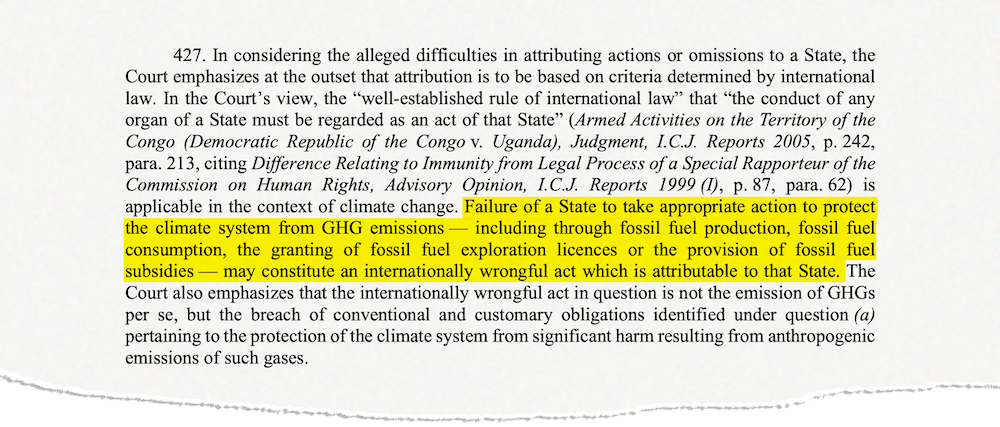
The court says that fossil-fuel production, consumption, the granting of exploration licences or the provision of subsidies “may constitute an internationally wrongful act” attributable to the state or states involved.
It comes after multiple analyses have concluded that any new oil and gas projects globally would be “incompatible” with limiting global warming to 1.5C.
Speaking to Carbon Brief, climate law expert Prof Jorge Viñuales notes that the clear mention of fossil fuels comes despite not being featured in the questions posed to the court:
“The request characterised the conduct to be assessed by reference to emissions, so the court could have stayed there. Yet, the relevant conduct was expanded to production and consumption of fossil fuels, including subsidies.”
Though the advisory opinion is not legally binding on countries, it could influence domestic decision-making around granting permissions to new fossil fuel projects going forward, adds Joy Reyes, a policy officer at the Grantham Research Institute on Climate Change and the Environment at the London School of Economics. She tells Carbon Brief:
“Litigants can cite the advisory opinion in future climate litigation, which includes the language around fossil fuels. While not legally binding, the advisory opinion carries moral weight and authority, and can influence domestic decision-making around new fossil-fuel projects. If states and corporations fail to transition away from fossil fuels, their risk for liability increases.”
The post ICJ: What the world court’s landmark opinion means for climate change appeared first on Carbon Brief.
ICJ: What the world court’s landmark opinion means for climate change
Greenhouse Gases
China Briefing 18 September 2025: MEE on the move; AI and energy; BRICS and climate
Welcome to Carbon Brief’s China Briefing.
China Briefing handpicks and explains the most important climate and energy stories from China over the past fortnight. Subscribe for free here.
Key developments
Huang reported to lawmakers on climate action
NPCSC REPORT: Huang Runqiu, head of the Ministry of Ecology and Environment, told Chinese lawmakers that managing the country’s carbon dioxide (CO2) intensity has become “more challenging” due to the effects of the Covid-19 pandemic, extreme weather and growing trade tensions, Bloomberg reported. According to the full text of Huang’s remarks, made during a report to the National People’s Congress (NPC) Standing Committee, the minister remarked that China’s progress on meeting the target is “broadly in line” with its current international climate pledge for 2030. [Its CO2 intensity target for 2025 is likely to be missed.] He added that challenges have worsened around balancing climate action with economic development, managing “overall and local interests” and “aligning short-term with medium-to-long-term goals”.
TARGETS ‘SURPASSED’: Huang also highlighted the progress China had made in other areas, having “already surpassed” targets for wind and solar power capacity additions and new forest stock volume, the state-run newspaper China Daily said. According to current affairs outlet China News, Huang also noted that China has continued its “efforts to enhance the clean and efficient utilisation of fossil fuels”, including “reforms” for coal-fired power plants and “steadily increasing” gas production and utilisation.

GLOBAL INFLUENCE: China is “making important contributions to the implementation of the Paris Agreement”, Huang also said, according to the full text of his remarks, having “driven substantial reductions in the costs of wind and solar power” and “advanced international cooperation on climate change”, such as in south-south collaboration. He noted that in the face of “uncertainties”, such as the US withdrawal from the Paris Agreement and the expansion of the EU’s carbon border adjustment mechanism, China will enhance its “influence, guidance and shaping power in global climate governance”.
Movements ahead of UNGA
COP30 SIGNALS: Former climate envoy Xie Zhenhua travelled with Huang to Brussels to meet EU climate lead Teresa Ribera on 16 September, Reuters reported, in order to restart “climate negotiations” ahead of the UN general assembly and COP30. It added that current climate envoy Liu Zhenmin was not expected to be present. (A photo posted on Bluesky confirmed Xie’s presence in the city.) A few days earlier, COP30 executive director Ana Toni met Huang in Beijing, where he told her that China will support Brazil in hosting a COP that “sends a strong signal” about the importance of the Paris Agreement, climate news outlet Tanpaifang reported. Toni told reporters that Brazil expects a “huge Chinese delegation” at COP, the Global Times said. She also spoke at an event at Tsinghua University attended by Xie and followed online by Carbon Brief.
UK-CHINA: Meanwhile, the UK and China established a new industrial decarbonisation working group, according to a UK government statement, focusing on areas including carbon capture, utilisation and storage. Daniel Brooker, the head of the China office at UK Research and Innovation, told finance news outlet Yicai that climate cooperation with China is “one of our immediate priorities”.
INTERCONNECTED WORLD: Separately, vice-president Han Zheng used a conference speech to urge other countries to cooperate on developing “renewable energy generation, grid interconnectivity and smart energy systems” as a way of advancing the global energy transition, according to the Communist party-affiliated newspaper People’s Daily.
First auction under new renewable pricing system
LOWER PRICES: Shandong province held the country’s first renewable power auction, following the launch of new rules for the pricing of wind and solar power, industry news outlet BJX News reported, with the auction price of wind power set at 0.319 yuan per kilowatt-hour (yuan/kWh) and those for solar set at 0.225 yuan/kWh. The low prices set by the “bellwether” province signalled that “renewables prices [across China] in the future will be lower than under the previous system”, Reuters said, adding that it could “discourage” further investment. On LinkedIn, David Fishman, principal at the Lantau Group, said that while the wind power prices would likely be acceptable for developers, the solar prices would be “very tough”, citing one as saying they would likely “abandon” all future projects in the province.
-
Sign up to Carbon Brief’s free “China Briefing” email newsletter. All you need to know about the latest developments relating to China and climate change. Sent to your inbox every Thursday.
PLANS ‘PROMPT’: Meanwhile, the National Energy Administration (NEA) urged local governments during a video conference to “promptly” release their plans for implementing the pricing reforms, energy news outlet International Energy Net said, to “stabilise” industry expectations. Separately, the NEA revealed during the conference that, between January and July 2025, China’s installed renewable energy capacity grew by 283 gigawatts (GW) to 2,171GW, current affairs outlet China News reported. In August, BJX News said, thermal-power generation grew by 1.7% – slower than July’s growth rate – while wind power grew by just over 20%, solar grew by 16% and hydropower fell by 10%.
LOCALISED PROJECTS: The NEA also co-released a notice on “improving pricing mechanisms” for localised new-energy projects, International Energy Net reported, referring to projects that “both generate and consume electricity” such as zero-carbon industrial parks. The notice outlined benchmarks for how much of their own renewable energy such projects should sell and consume, clarifying that such projects should “bear transmission and distribution fees, system operation costs and other expenses”, it added.
China set targets for new AI energy projects
AI PILOTS: China plans to increase the use of AI in the country’s energy sector, state news agency Xinhua reported, in order to “enhance energy security, improve operational efficiency and support the country’s green and low-carbon transition”. China will “promote the deep application of at least five specialised large models”, which could be used in the power grid, power generation, coal, oil, gas or other areas, according to industry news outlet China Energy News. It also reported that China plans to identify ten or more “replicable, scalable and competitive” pilot projects. Consulting firm Trivium China wrote in a note that the plan “positions AI as an indispensable tool” on climate change.
DOUBLING STORAGE: China aims to “almost double” new-energy storage capacity by 2027 to 180GW, according to a new industry plan, Reuters reported. Lithium-ion battery storage is likely to comprise the bulk of new additions, economic news outlet Jiemian said. Meanwhile, according to a new government action plan for 2025-2026, new-energy power equipment companies are expected to achieve “steady” annual revenue increase, while traditional power equipment firms should aim to grow “approximately 6%” and “leading” companies by 10%, Xinhua said.
POLICY WATCH: China adopted the atomic energy law, its first foundational law for the nuclear sector, Jiemian reported. China’s environmental code – also the first of its kind – remains under discussion, according to China News. Elsewhere, the country updated its plan to “advance the three-north shelterbelt forest programme”, China Daily said. The National Development and Reform Commission called for “exploring” pathways for real estate investment trusts to invest in ultra-high voltage transmission projects, BJX News reported. BJX News also covered new guidance on improving electricity spot markets.
Spotlight
Q&A: Will China and the BRICS fill the ‘leadership gap’ on climate change?
Amid a rapidly fracturing geopolitical order, there have been growing calls for China to “step into [the] leadership gap” left by the US on climate change.
One platform that it could use to do so is BRICS, an increasingly influential and assertive group that includes COP30 host Brazil.
In this issue, Carbon Brief explores whether or not China, alongside the BRICS, could become climate leaders. The full article is available on Carbon Brief’s website.
The BRICS group represents a number of emerging economies that aim to “increas[e] the influence of global south countries in international governance”.
Active full members include founding members Brazil, Russia, India and China, as well as South Africa, Egypt, the United Arab Emirates, Ethiopia, Indonesia and Iran.
Together, they represent 27% of global gross domestic product, 49% of the world’s population and 52% of carbon dioxide emissions, according to Carbon Brief calculations.
Four of the members – Brazil, China, India and South Africa – also form the BASIC bloc, a group with a significant voice at UN climate summits and other negotiations.
How do the BRICS approach climate change?
Lucas Carlos Lima, professor of international law at the Federal University of Minas Gerais in Brazil, wrote that recent joint statements show the BRICS had “placed climate change squarely at the centre of the bloc’s agenda”.
In July, the BRICS summit resulted in a joint declaration demanding that “accessible, timely and affordable climate finance” is provided to developing countries.
The statement also highlighted the nations’ “resolve to remain united in the pursuit of the purpose and goals of the Paris Agreement”.
However, the BRICS leaders’ declaration also “acknowledge[s] fossil fuels will still play an important role in the world’s energy mix”.
The inclusion of this language “undermin[es] the positives” of the bloc’s other statements on climate action, according to a response from Jacobo Ocharan, head of political strategies at Climate Action Network International.
What is the role of fossil fuels in the BRICS?
Many BRICS nations remain heavily reliant on fossil fuels, both for electricity generation and to support their wider energy systems.
However, this picture is starting to shift, with almost all BRICS members having adopted net-zero targets ranging from 2050 to 2070.
More tangibly, the addition of new clean-power projects means that fossil-fueled electricity generating capacity now makes up less than half of the installed total in the BRICS group as a whole in 2024, as shown in the figure below.
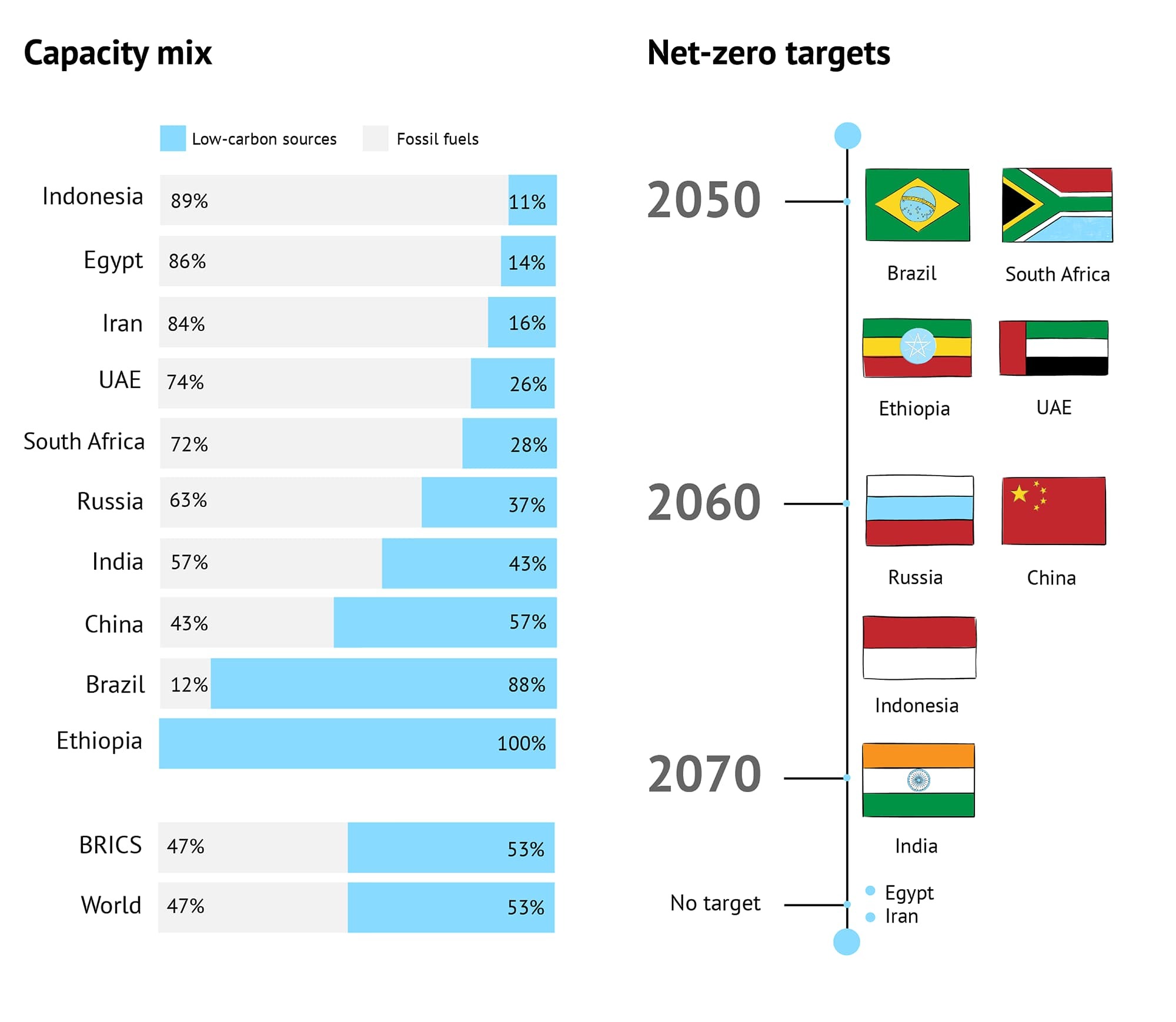
Non-fossil power, driven by “unprecedented” renewable energy growth in China, India and Brazil, accounted for 53% of the installed electricity generating capacity in BRICS countries in 2024, according to thinktank Global Energy Monitor (GEM).
Continued BRICS focus on clean energy makes it “unlikely that fossil capacity will overtake non-fossil again”, James Norman, research analyst at GEM, told Carbon Brief.
Several BRICS members, including Russia, the UAE, Iran and Indonesia, are nevertheless leading producers and exporters of fossil fuels.
China and India, meanwhile, are by some distance the world’s largest and second-largest coal users, respectively.
Nevertheless, in the short term, this might not affect the BRICS group’s climate ambition overall.
Russia does not seem to be “blocking” the “solid outcomes” of recent BRICS climate negotiations, said Kate Logan, director of the China climate hub and climate diplomacy at the Asia Society Policy Institute (ASPI).
Will China and the BRICS emerge as climate leaders?
With the withdrawal of the US from the Paris Agreement under the Trump administration, there have been increasing calls for China to take up the mantle of climate leadership.
China, at least publicly, is eschewing these calls, but does seem to be open to agreeing to “demonstrate leadership” in tandem with others, as seen in an EU-China joint statement on climate change published in late July.
Many are watching for signs of whether China’s upcoming international climate pledge, which may be published next week, will contain ambitious targets that will encourage greater global ambition.
Beatriz Mattos, research coordinator at Brazil-based climate-research institute Plataforma CIPÓ, tells Carbon Brief that China’s position as a “major investor in the renewable energy sector” means there is “enormous potential” for both it and the BRICS to assume a climate leadership role.
Watch, read, listen
NEW PARTNERS: The China-Global South Podcast examined the “stunning 113% jump” in Chinese investment into Brazil, a significant share of which was in oil and renewable energy.
PEAK ESTIMATE: A new report by Greenpeace East Asia found that China could “peak its power emissions in 2025”, at just over 5bn tonnes.
INSIDER VOICES: Three leading experts on China’s energy transition shared their insights in an event broadcasted by the Center for China and Globalization.
RESHAPING ENERGY: Ember published a “comprehensive review” of China’s energy transition and how it is “transforming global energy realities”.
$210 billion
The amount of foreign investment pledged by Chinese clean-energy technology manufacturers since 2022, according to a new report by the Net Zero Industrial Policy Lab covered by Bloomberg.
New science
Agricultural and Forest Meteorology
A new study examined the combined role of “forest activities and fire disturbance” (FAFD) on the effectiveness of China’s carbon sinks. It estimated that, between 1986 and 2020, the carbon emissions resulting from harvesting forests and forest fires offset around 54% of the carbon sequestration occurring through forestation. These findings, the authors said, “highlight the importance of accounting for carbon emissions from deforestation and forest fire when aiming to maximise carbon sequestration through forestation”.
Temperature extremes in early life and human capital: evidence from China’s labour market
Climatic Change
“Early-life exposure” to both extreme heat and extreme cold has “significant and persistent negative effects on adult labour income”, new research has found. The study, which draws from a dataset of more than one million individuals from China, said that, under a scenario with moderate warming (SSP2-4.5), average labour-income loss across China could total 0.77%, with the provinces of Qinghai, Henan, Fujian and Gansu most severely affected. It added that the impact of extreme heat on foetuses is “particularly pronounced”, with significant implications for future earnings.
China Briefing is compiled by Wanyuan Song and Anika Patel. It is edited by Wanyuan Song and Dr Simon Evans. Please send tips and feedback to china@carbonbrief.org
The post China Briefing 18 September 2025: MEE on the move; AI and energy; BRICS and climate appeared first on Carbon Brief.
China Briefing 18 September 2025: MEE on the move; AI and energy; BRICS and climate
Greenhouse Gases
Q&A: Will China and the BRICS fill the ‘leadership gap’ on climate change?
Amid a rapidly fracturing geopolitical order, there have been growing calls for China to “step into [the] leadership gap” left by the US on climate change.
While China has resisted such suggestions – at least officially – it has spent much of the past 12 months nurturing its international status as a partner for other countries, in areas ranging from the economy and global governance through to climate change.
President Xi Jinping has maintained a schedule packed with foreign-policy engagements, meeting with world leaders from Russia and India through to the EU.
Moreover, this April he made his first international climate speech since 2021, while attending a meeting on climate and the just transition hosted by Brazil.
As well as underscoring his nation’s ongoing commitment to climate action, Xi’s presence also hinted at the growing coordination between China and Brazil in this area.
More broadly, there is growing recognition of greater alignment between non-western countries – particularly in the global south – in the face of more aggressive US foreign policy.
Analysts note that pressure from the US could push groups such as the BRICS – of which Brazil and China are two founding members, alongside Russia and India – to become more cohesive and develop more concrete cooperation channels.
In a recent interview with Carbon Brief, UK climate envoy Rachel Kyte said that the “world is changing”, becoming “flatter” and that the BRICS – which now includes 11 countries, including South Africa, Egypt and Indonesia – are “more and more important”.
This Q&A explores the membership, climate stance and energy sectors of the BRICS nations, as well as the potential for China and the bloc to lead on climate change.
- What is the BRICS group?
- How do the BRICS approach climate change?
- Are Brazil and China in the BRICS ‘driving seat’?
- What is the role of fossil fuels in the BRICS?
- What is the economic impact of clean-tech?
- Will China and the BRICS emerge as climate leaders?
What is the BRICS group?
The BRICS group represents a number of emerging economies that aim to “strengthen” cooperation amongst themselves and to “increas[e] the influence of global south countries in international governance”.
They coordinate on a range of topics, from international finance to climate diplomacy.
It was founded by Brazil, Russia, India and China – hence, the original name “BRIC” – which later became “BRICS” with the inclusion of South Africa. More recently, it expanded again to include Egypt, the United Arab Emirates, Ethiopia, Indonesia and Iran.
Saudi Arabia has been formally invited to join the bloc, but has not yet accepted the invitation. A number of others participate in the grouping as partner countries, including Malaysia, Thailand and Nigeria.
Together, the full members of the group represent 27% of global gross domestic product (GDP), 49% of the world’s population and 52% of emissions, according to Carbon Brief calculations illustrated below.
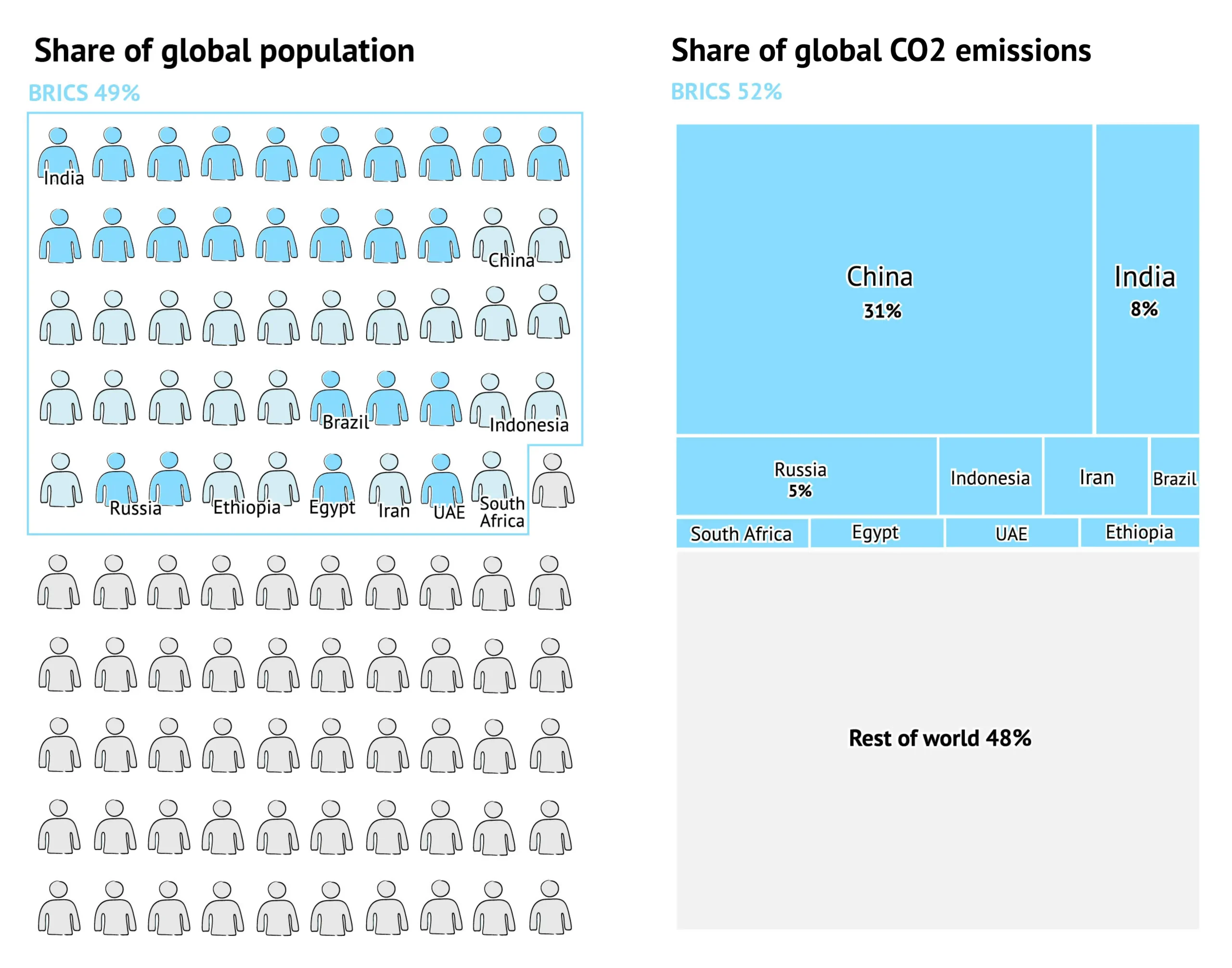
Four of the members – Brazil, China, India and South Africa – also form the BASIC bloc, a group with a significant voice at UN climate summits and other negotiations.
BASIC was formed in Beijing in 2009, with representatives from the four countries meeting to coordinate on climate negotiations from the standpoint of major emerging economies.
This culminated at the COP15 climate talks in Copenhagen in 2009, when the BASIC group issued a joint set of “non-negotiable terms” and went on to work directly with the US to agree the Copenhagen Accord.
The bloc has used less combative tactics in subsequent COPs, but it continues to issue joint statements on climate change and to strongly advocate for certain issues.
At both COP28 and COP29, BASIC submitted a proposal to have “unilateral trade measures related to climate change” – referring to policies such as the EU’s carbon border adjustment mechanism (CBAM) – added to the meeting agenda.
The request was denied both times.
How do the BRICS approach climate change?
Alongside BASIC, the BRICS group is also becoming increasingly focused on climate policy.
COP30 executive director Ana Toni, speaking at a September 2025 event at Tsinghua University attended online by Carbon Brief, said that BRICS countries have “realised that climate is not just a financial issue or a niche”, but rather a “pillar for prosperity, development and growth”.
Lucas Carlos Lima, professor of international law at the Federal University of Minas Gerais in Brazil, wrote in an April 2025 article for Modern Diplomacy that recent joint statements show the BRICS had “placed climate change squarely at the centre of the bloc’s agenda”.
The group has also been playing an increasingly significant role in other multilateral fora. For example, a BRICS proposal at the COP16 UN biodiversity negotiations in February formed the basis of an agreement to mobilise at least $200bn per year to protect nature.
Susana Muhamad, president of the COP16 nature talks, told Reuters in March that BRICS nations had been “bridge builders” in the negotiations.
She added:
“I understand there’s a lot of countries wanting to join BRICS, because…if you have to confront something like the US, you are not alone.”
Environment ministers of BRICS countries also recently issued a joint statement that “reaffirm[ed] our steadfast commitments” to addressing climate change, adding that BRICS “can positively contribute to…the global environmental agenda.”
Their finance ministers also agreed in May on a climate-finance framework, outlining priorities including “the reform of multilateral development banks, the scaling up of concessional finance and the mobilising of private capital to support climate efforts in the global south”.
The framework represents “common and collective BRICS action in the area of climate finance” for the first time, notes Tatiana Rosito, international affairs secretary at Brazil’s finance ministry.

The framework was adopted at the BRICS summit in July, where a number of leaders gathered to sign a joint declaration demanding that “accessible, timely and affordable climate finance” is provided to developing countries.
This, it adds, “is a responsibility of developed countries” under the Paris Agreement.
The statement also highlighted the nations’ “resolve to remain united in the pursuit of the purpose and goals of the Paris Agreement”, featuring 21 paragraphs in a section on climate change spanning just transitions, carbon markets and critical minerals.
“It is encouraging that BRICS nations called for more climate lending, deeper green bond markets and better carbon accounting,” Mirela Sandrini, interim executive director for Brazil at the World Resources Institute, said in a statement. She added:
“South-south collaboration of this scale and ambition can inject much-needed momentum into international climate diplomacy ahead of COP30.”
However, the BRICS leaders’ declaration also “acknowledge[s] fossil fuels will still play an important role in the world’s energy mix, particularly for emerging markets and developing economies”.
The inclusion of this language “undermin[es] the positives” of the bloc’s other statements on climate action, according to a response from Jacobo Ocharan, head of political strategies at Climate Action Network International.
Manuel Pulgar-Vidal, global climate and energy lead at WWF, agrees, saying climate change is “treated as background noise” in the joint statement, with “no clear articulation of the BRICS+ role in the global climate response”.
Are Brazil and China in the BRICS ‘driving seat’?
Much of the recent BRICS focus on climate change is due to Brazil being “in the driver’s seat”, says Kate Logan, director of the China climate hub and climate diplomacy at the Asia Society Policy Institute (ASPI), speaking to Carbon Brief.
As well as hosting COP30, Brazil recently chaired the G20 and is currently presiding over the BRICS. It used both of these forums to prioritise climate action on the agenda, she adds.
There has been frequent coordination between COP30, Brazilian and Chinese officials in the run-up to the conference.
This included a meeting of BRICS environment ministers held in April 2025, a separate April meeting between COP30 president André Corrêa do Lago and Chinese minister for the environment and ecology Huang Runqiu, as well as an earlier meeting in March between Huang and UN climate chief Simon Stiell.
Most significantly, Chinese president Xi Jinping appeared at a closed-door April 2025 meeting of global leaders organised by the UN and Brazil, telling his audience that “China’s actions to address climate change will not slow down”.
Many analysts saw the statement as a clear signal of China’s support for multilateralism, in sharp contrast to the US withdrawing from climate negotiations.
Xi’s participation in the meeting also underscored growing solidarity between China and Brazil on accelerating climate action.
Brazil and China have a long history of cooperation on environmental issues, including through the China-Brazil High-Level Coordination and Cooperation Commission (COSBAN).
The Brazilian government describes COSBAN as the “highest-level governmental mechanism” between the two countries. It includes tracks specifically focused on energy, agriculture and mining, as well as the environment and climate change.
But there has been a notable uptick in engagement under the new Lula administration.
For the current Brazilian administration, China is an “essential partner in global climate solutions”, according to a briefing note published by the Brazilian climate network Observatório do Clima.
A related opinion article in Brazilian newspaper Folha de S. Paolo, written by Stela Herschmann, climate policy specialist at the Observatório do Clima, and Beibei Yin, founder of environmental consultancy Bambu Consulting, argues that China and Brazil could form the “new G2” – the moniker given to the US-China alignment that they say shaped global climate policy for “more than two decades”.
They add that Brazil, through its unique role in the world and current position, can help “fill the current vacuum” of climate leadership. They write:
“Brazil enjoys the respect of the international community because it often mediates the divisions between developed and developing countries in climate negotiations…The presidency of COP30 and BRICS adds to this, making the country a natural candidate to fill the current vacuum of climate leadership.”
However, the two countries’ climate approaches have diverged at times.
Jennifer Allan, senior lecturer in international relations at Cardiff University, tells Carbon Brief: “These countries have several similar views, but also have diverged in the past.”
For example, she says, Brazil’s suggestion at COP26 of a “concentric” approach to cutting emissions, with emerging economies offering more stringent targets than other developing countries, was opposed by China, which wanted to “maintain the firewall” between developed and developing countries.
What is the role of fossil fuels in the BRICS?
Many BRICS nations remain heavily reliant on fossil fuels, both for electricity generation and to support their wider energy systems.
However, this picture is starting to shift, with almost all BRICS members having adopted net-zero targets ranging from 2050 for Brazil, South Africa and others, through to 2060 for China and Russia, or 2070 for India.
More tangibly, the addition of new clean-power projects means that fossil-fueled electricity generating capacity now makes up less than half of the installed total in the BRICS group as a whole in 2024, as shown in the figure below.

Non-fossil power, driven by “unprecedented” renewable energy growth in China, India and Brazil, accounted for 53% of the installed electricity generating capacity in BRICS countries overall in 2024, according to recent analysis by the thinktank Global Energy Monitor (GEM). This puts them in line with the global average.
Ethiopia, Brazil and China boast higher-than-average shares of clean capacity – at 100%, 88% and 57% respectively. India’s clean-capacity share stands at 43%.
Continued BRICS focus on clean energy makes it “unlikely that fossil capacity will overtake non-fossil again”, James Norman, research analyst at GEM, tells Carbon Brief, adding that much of this is driven by significant renewable additions in some members, particularly China.
While some BRICS members are continuing to commission “significant amounts of new coal-fired capacity”, he says, it remains uncertain whether these new plants will be completed, or if they will go on to operate at full capacity.
Several BRICS members are also leading producers and exporters of fossil fuels. Russia is a major exporter of all types of fossil fuels, the Statistical Review of World Energy shows, while the UAE, Iran and Indonesia have large oil- or coal-exporting industries.
The data shows that China and India, meanwhile, are by some distance the world’s largest and second-largest coal users, respectively, predominantly fueled by domestic mining. China alone accounts for more than half of global coal production and use.
Norman acknowledges that “fossil dominance remains largely unchanged” among some BRICS members.
He states that countries such as Iran, with “entrenched modes of power production”, or with “limited strategic interest in overhauling the energy sector, such as Russia”, are on a different trajectory to countries such as Brazil or China.
Nevertheless, he says, the “strong economic case for solar and wind”, as well as the fact that nearly all BRICS countries have announced renewable energy targets, “makes continued growth in clean energy across the group highly likely”.
In the short term, meanwhile, the continued reliance of some members on fossil fuels might not lessen the BRICS group’s climate ambition overall. It is “notable” that Russia does not seem to be “blocking” the “solid outcomes” of recent BRICS climate negotiations, Logan tells Carbon Brief.
Indeed, the 2024 Kazan declaration, which featured a lengthy and detailed section on climate change, was released under the Russian BRICS presidency.
Still, the group is not a united front in all areas, for example the rivalry between China and India. Tensions remain high between the two countries on a number of issues, from border disputes to supply chains and geopolitical alliances.
This has spilled into climate-related topics, with India complaining about China’s construction of mega-dams in the Himalayas and launching anti-dumping investigations into solar imports from China.
At COP29, China and India at times took up conflicting stances during negotiations – most notably during the final stages of the climate finance deal, where China “helped prevent” efforts by India to block the deal, Logan wrote in an analysis for Dialogue Earth.
Another area of contention for India at COP29 was CBAM, which it said contributed to a “very, very competitive, hostile environment” that made it “difficult” to enable an energy transition.
By contrast, Logan tells Carbon Brief, China is “much less worried” about CBAM.
(Brazil, too, is unlikely to push hard to include CBAM and other “unilateral” trade measures in the COP30 agenda, Allan says, in order to maintain its “neutral” position as the holder of the COP presidency and the trust of other parties. Indeed, it is reportedly pushing for this issue to be taken up in a new forum, completely outside the climate talks.)
Nevertheless, India and China are united in climate negotiations by their commitment to ensuring all agreements uphold the principle of common but differentiated responsibilities and respective capabilities (CBDR-RC).
“This is something [in which] they’ll continue to be aligned”, Logan says, “but how it plays out in practice is where you start to see divergences”.
A recent rapprochement in China-India relations saw Indian prime minister Narendra Modi visit China for the first time in seven years.
The two countries also came together at the International Maritime Organization, where they successfully pushed for publicly-available data on shipping emissions to be anonymised.
Earlier, Brazil, China, South Africa and several other developing countries also lobbied against the creation of a global levy on shipping emissions.
Allen notes that whether or not BRICS and BASIC can align on climate may, ultimately, be a moot point, given that BASIC is just one of several coalitions that China operates in and that it is currently “less active” than other coalitions.
For example, she says, unlike the Like-Minded Developing Countries (LMDC) group, BASIC “doesn’t negotiate as a group in contact groups” at the UN climate talks. She adds:
“Multiple coalitions are a way for [a country] to multipl[y] their influence, while also perhaps hiding its individual views among those of the group.”
What is the economic impact of clean-tech?
Beyond the realms of climate diplomacy, it is increasingly clear that there is a hard-nosed economic reality to the positions being taken by China and other BRICS nations.
Indeed, as China works with Brazil and the BRICS to centre emerging markets’ concerns in climate policy, it also plays a key role in the economics of the energy transition.
The country accounts for more than 80% of global solar manufacturing, more than 70% of electric vehicle production and more than 75% of battery production.
While most of this is consumed domestically, exports of each of these categories – which it often calls the “new-three” – are “booming”, finance news outlet Caixin reports.
Historically these exports would have been destined for developed countries. But, in 2024, “half of all China’s exports of solar and wind power equipment and electric vehicles (EVs) [went] to the global south”, Lauri Myllyvirta and Hubert Thieriot, lead analyst and data lead at the Centre for Research on Energy and Clean Air (CREA), write at Dialogue Earth.
Separate analysis by Myllyvirta for Carbon Brief revealed that China’s exports of clean-energy technologies in 2024 alone will reduce emissions in the rest of the world by 1%, avoiding some 4bn tonnes of carbon dioxide (CO2 over their lifetimes).
Moreover, clean-energy industries accounted for more than 10% of China’s GDP in 2024 for the first time ever, driving a quarter of economic growth that year.
Meanwhile, Chinese lending overseas is also increasingly focused on low-carbon infrastructure, according to the Boston University Global Development Policy Center.
Their analysis finds that the “share of renewable energy in China’s portfolio has increased significantly”, with solar and wind projects “dominat[ing]” the types of projects funded in 2022 and 2023.
This stands in sharp contrast to typical Chinese lending activity before 2021, which showed a preference for conventional power projects, such as coal and hydropower.
According to Myllyvirta and Thieriot, the “important role that clean-energy technology plays in the country’s economy and exports” will encourage China to ensure that the global energy transition “keeps accelerating”.
They add: “That will be seen in bilateral lending and diplomacy, and could also lead the country to take more forward-leaning positions in multilateral climate negotiations.”
Will China and the BRICS emerge as climate leaders?
With the withdrawal of the US from the Paris Agreement under the Trump administration, there have been increasing calls for China to take up the mantle of climate leadership.
Many are watching for signs of whether China’s upcoming international climate pledge, which may be published by the UN general assembly meeting next week, will contain ambitious targets that will encourage greater global ambition.
Beatriz Mattos, research coordinator at Brazil-based climate-research institute Plataforma CIPÓ, tells Carbon Brief that China’s position as a “major investor in the renewable energy sector” means there is “enormous potential” for both it and the BRICS to assume a climate leadership role.
China, at least publicly, is eschewing these calls. In an interview with state-owned magazine China Newsweek, climate envoy Liu Zhenmin said in response to a question about China’s climate leadership that the calls are just “the west giving us a ‘tall hat’” – an expression meaning trying to flatter China. He added:
“Of course, within their respective camps, major countries should play a more leading role, such as the EU and US in the developed countries camp, and the BASIC countries in the developing countries camp. But BASIC cannot be a substitute for all developing countries, and developing countries will still participate in [climate] negotiations within the framework of ‘G77+China’. This is the basis for cooperation in the global south.”
Notably, this does not seem to preclude China from agreeing to “demonstrate leadership” in tandem with others, as seen in an EU-China joint statement on climate change published in late July.
BASIC is “important for China in climate negotiations given the influence of other large emerging economies”, Yixian Sun, associate professor in international development at the University of Bath, tells Carbon Brief.
“On many issues (especially sensitive issues regarding its developing country status), China doesn’t want to stand out by itself,” he says, with the grouping providing cover in negotiations.
Mattos agrees, stating that “remaining part of this group serves as a way [for China] to reinforce its identity as a developing country in climate negotiations”.
More broadly, it will likely continue to align with the other BRICS nations, when this offers a way to advance its positions in climate negotiations.
Sun expects Brazil and China to sustain their elevated levels of climate cooperation even after Brazil hands over the COP presidency, based on their 2023 joint statement. However, he says there are still questions around what new bilateral climate initiatives would look like and how “concrete” they would be in practice.
Looking ahead, Logan notes, BRICS could also be in a position to sustain its influence if India hosts COP33 in 2028.
“BRICS has in multiple documents endorsed India’s bid for COP33”, she says, which, given India’s presidency of BRICS in 2026, could allow Brazil and China to “influence India in a more constructive direction” on climate, over a number of years.
The post Q&A: Will China and the BRICS fill the ‘leadership gap’ on climate change? appeared first on Carbon Brief.
Q&A: Will China and the BRICS fill the ‘leadership gap’ on climate change?
Greenhouse Gases
Analysis: India’s power-sector CO2 falls for only second time in half a century
India’s carbon dioxide (CO2) emissions from its power sector fell by 1% year-on-year in the first half of 2025 and by 0.2% over the past 12 months, only the second drop in almost half a century.
As a result, India’s CO2 emissions from fossil fuels and cement grew at their slowest rate in the first half of the year since 2001 – excluding Covid – according to new analysis for Carbon Brief.
The analysis is the first of a regular new series covering India’s CO2 emissions, based on monthly data for fuel use, industrial production and power output, compiled from numerous official sources.
(See the regular series on China’s CO2 emissions, which began in 2019.)
Other key findings on India for the first six months of 2025 include:
- The growth in clean-energy capacity reached a record 25.1 gigawatts (GW), up 69% year-on-year from what had, itself, been a record figure.
- This new clean-energy capacity is expected to generate nearly 50 terawatt hours (TWh) of electricity per year, nearly sufficient to meet the average increase in demand overall.
- Slower economic expansion meant there was zero growth in demand for oil products, a marked fall from annual rates of 6% in 2023 and 4% in 2024.
- Government infrastructure spending helped accelerate CO2 emissions growth from steel and cement production, by 7% and 10%, respectively.
The analysis also shows that emissions from India’s power sector could peak before 2030, if clean-energy capacity and electricity demand grow as expected.
The future of CO2 emissions in India is a key indicator for the world, with the country – the world’s most populous – having contributed nearly two-fifths of the rise in global energy-sector emissions growth since 2019.
India’s surging emissions slow down
In 2024, India was responsible for 8% of global energy-sector CO2 emissions, despite being home to 18% of the world’s population, as its per-capita output is far below the world average.
However, emissions have been growing rapidly, as shown in the figure below.
The country contributed 31% of global energy-sector emissions growth in the decade to 2024, rising to 37% in the past five years, due to a surge in the three-year period from 2021-23.
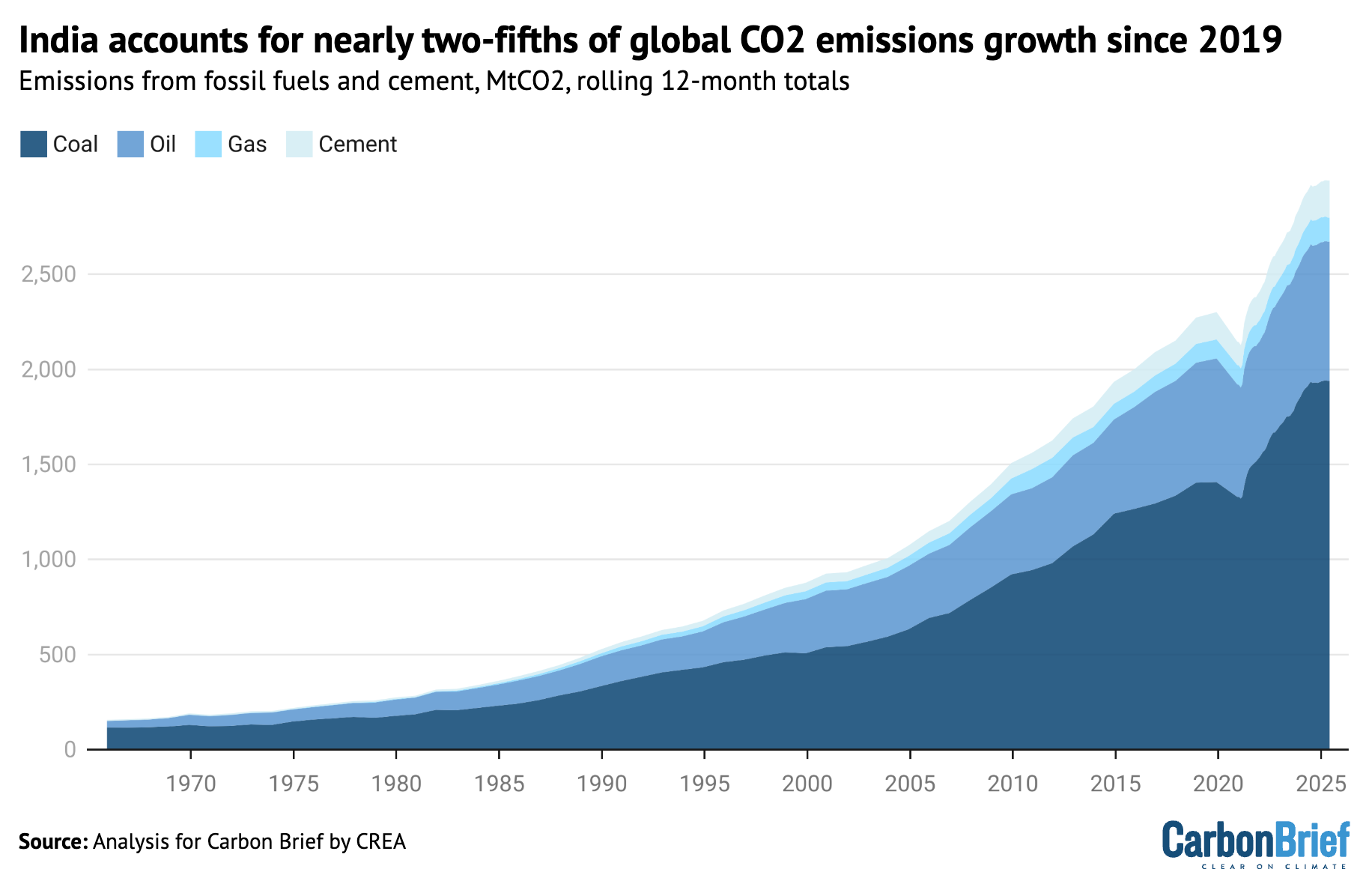
More than half of India’s CO2 output comes from coal used for electricity and heat generation, making this sector the most important by far for the country’s emissions.
The second-largest sector is fossil fuel use in industry, which accounts for another quarter of the total, while oil use for transport makes up a further eighth of India’s emissions.
India’s CO2 emissions from fossil fuels and cement grew by 8% per year from 2019 to 2023, quickly rebounding from a 7% drop in 2020 due to Covid.
Before the Covid pandemic, emissions growth had averaged 4% per year from 2010 to 2019, but emissions in 2023 and 2024 rose above the pre-pandemic trendline.
This was despite a slower average GDP growth rate from 2019 to 2024 than in the preceding decade, indicating that the economy became more energy- and carbon-intensive. (For example, growth in steel and cement outpaced the overall rate of economic growth.)
A turnaround came in the second half of 2024, when emissions only increased by 2% year-on-year, slowing down to 1% in the first half of 2025, as seen in the figure below.
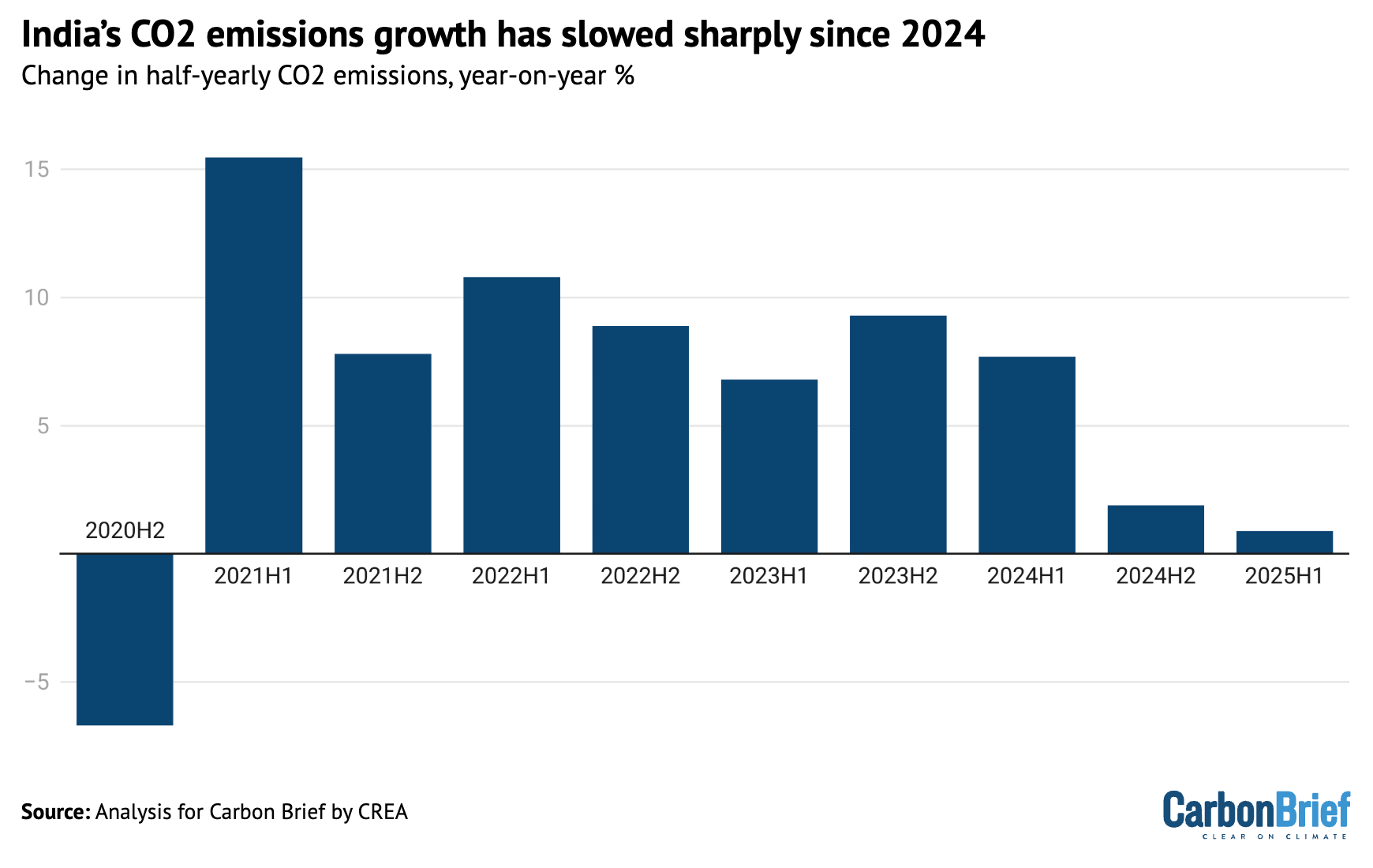
The largest contributor to the slowdown was the power sector, which was responsible for 60% of the drop in emissions growth rates, when comparing the first half of 2025 with the years 2021-23.
Oil demand growth slowed sharply as well, contributing 20% of the slowdown. The only sectors to keep growing their emissions in the first half of 2025 were steel and cement production.
Another 20% of the slowdown was due to a reduction in coal and gas use outside the power, steel and cement sectors. This comprises construction, industries such as paper, fertilisers, chemicals, brick kilns and textiles, as well as residential and commercial cooking, heating and hot water.
This is all shown in the figure below, which compares year-on-year changes in emissions during the second half of 2024 and the first half of 2025, with the average for 2021-23.

Power sector emissions fell by 1% in the first half of 2025, after growing 10% per year during 2021-23 and adding more than 50m tonnes of CO2 (MtCO2) to India’s total every six months.
Oil product use saw zero growth in the first half of 2025, after rising 6% per year in 2021-23.
In contrast, emissions from coal burning for cement and steel production rose by 10% and 7%, respectively, while coal use outside of these sectors fell 2%.
Gas consumption fell 7% year-on-year, with reductions across the power and industrial sectors as well as other users. This was a sharp reversal of the 5% average annual growth in 2021-23.
Power-sector emissions pause
The most striking shift in India’s sectoral emissions trends has come in the power sector, where coal consumption and CO2 emissions fell 0.2% in the 12 months to June and 1% in the first half of 2025, marking just the second drop in half a century, as shown in the figure below.
The reduction in coal use comes after more than a decade of break-neck growth, starting in the early 2010s and only interrupted by Covid in 2020. It also comes even as the country plans large amounts of new coal-fired generating capacity.
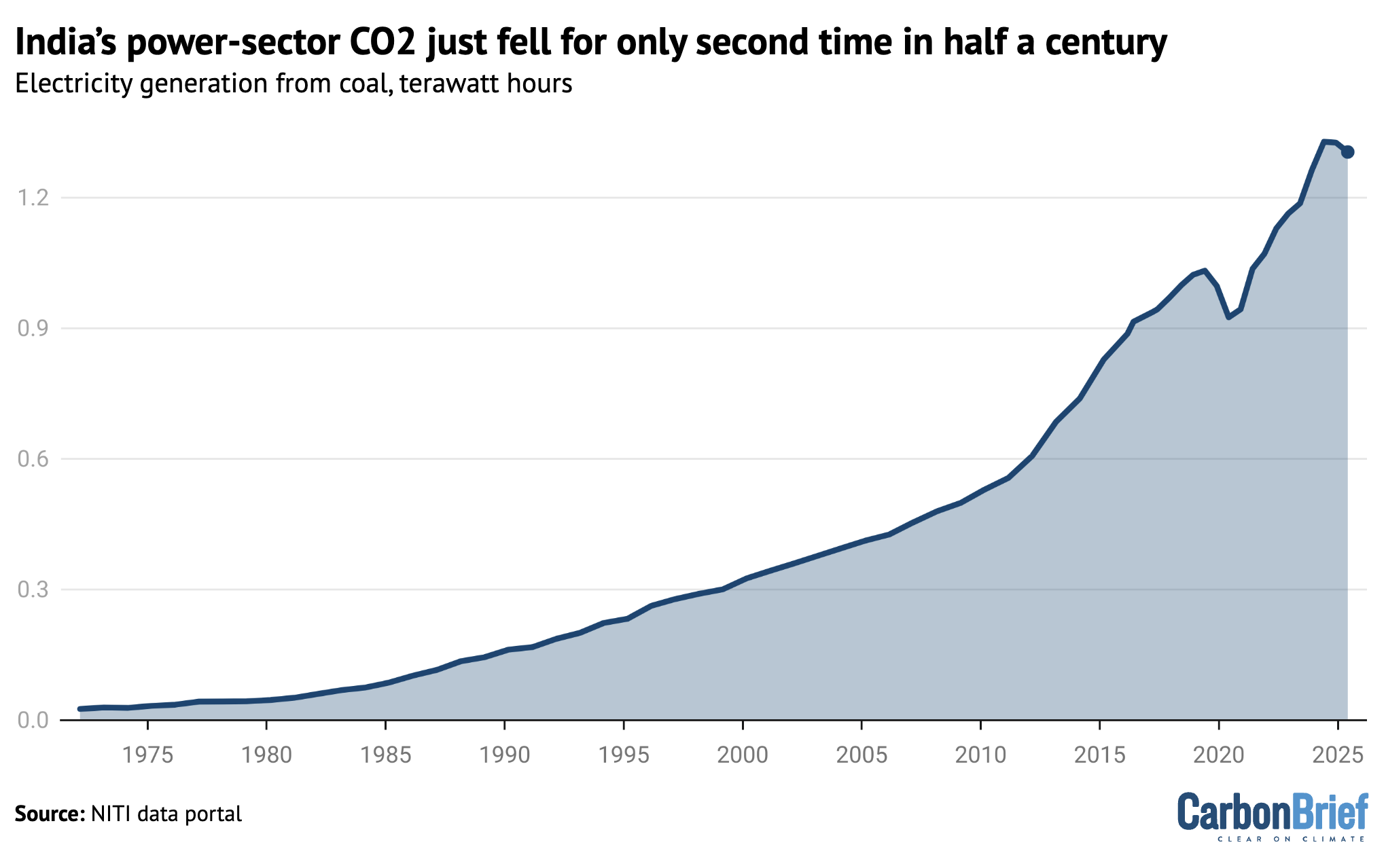
In the first half of 2025, total power generation increased by 9 terawatt hours (TWh) year-on-year, but fossil power generation fell by 29TWh, as output from solar grew 17TWh, from wind 9TWh, from hydropower by 9TWh and from nuclear by 3TWh.
Analysis of government data shows that 65% of the fall in fossil-fuel generation can be attributed to lower electricity demand growth, 20% to faster growth in non-hydro clean power and the remaining 15% to higher output at existing hydropower plants.
Slower growth in electricity usage was largely due to relatively mild temperatures and high rainfall, in contrast to the heatwaves of 2024. A slowdown in industrial sectors in the second quarter of the year also contributed.
In addition, increased rainfall drove the jump in hydropower generation. India received 42% above-normal rainfall from March to May 2025. (In early 2024, India’s hydro output had fallen steeply as a result of “erratic rainfall”.)
Lower temperatures and this abundant rainfall reduced the need for air conditioning, which is responsible for around 10% of the country’s total power demand. In the same period in 2024, demand surged due to record heatwaves and higher temperatures across the country.
The growth in clean-power generation was buoyed by the addition of a record 25.1GW of non-fossil capacity in the first half of 2025. This was a 69% increase compared with the previous period in 2024, which had also set a record.
Solar continues to dominate new installations, with 14.3GW of capacity added in the first half of the year coming from large scale solar projects and 3.2GW from solar rooftops.
Solar is also adding the majority of new clean-power output. Taking into account the average capacity factor of each technology, solar power delivered 62% of the additional annual generation, hydropower 16%, wind 13% and nuclear power 8%.
The new clean-energy capacity added in the first half of 2025 will generate record amounts of clean power. As shown in the figure below, the 50TWh per year from this new clean capacity is approaching the average growth of total power generation.
(When clean-energy growth exceeds total demand growth, generation from fossil fuels declines.)
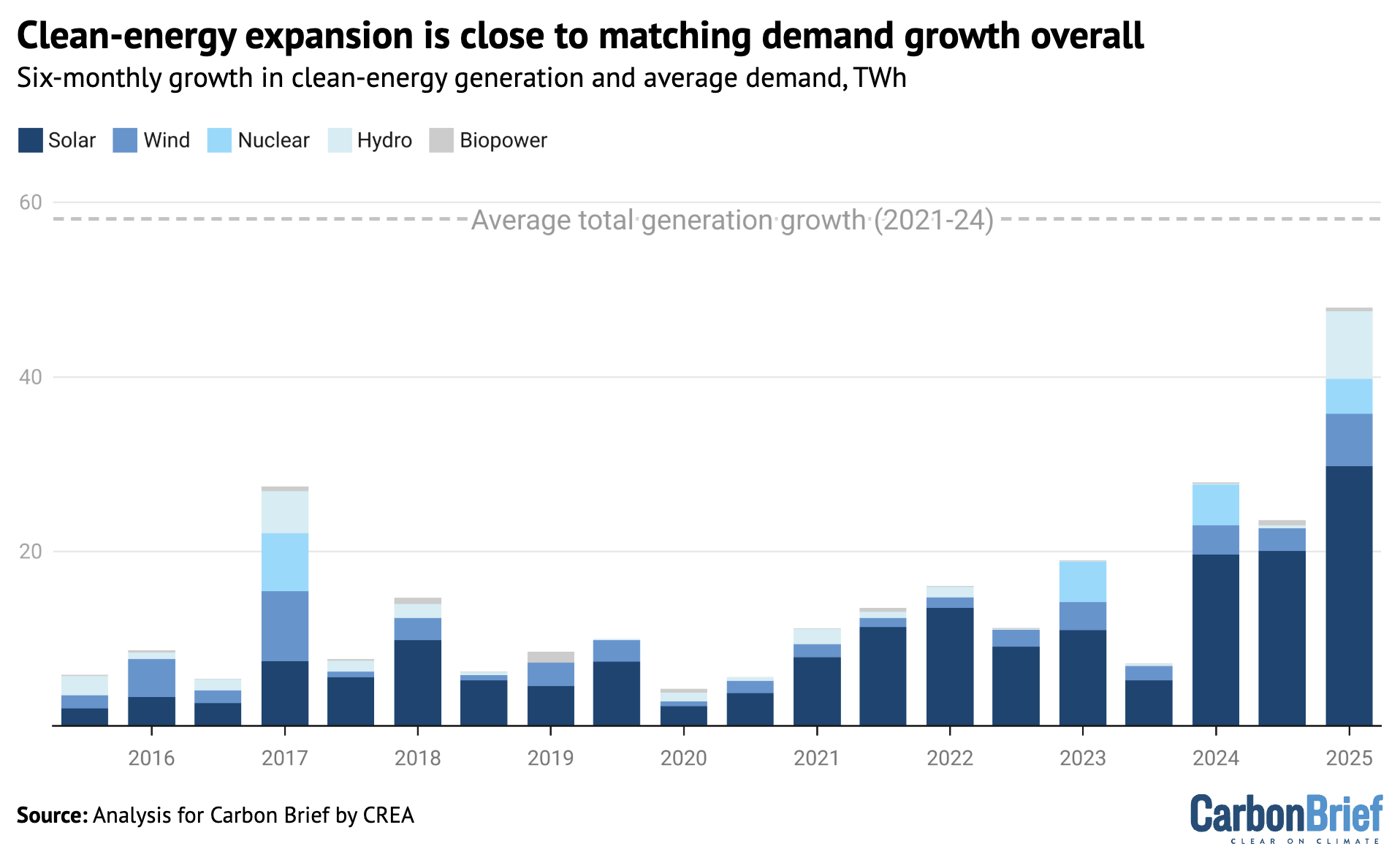
India is expected to add another 16-17GW of solar and wind in the second half of 2025. Beyond this year, strong continued clean-energy growth is expected, towards India’s target for 500GW of non-fossil fuel capacity by 2030 (see below).
Slowing oil demand growth
The first half of 2025 also saw a significant slowdown in India’s oil demand growth. After rising by 6% a year in the three years to 2023, it slowed to 4% in 2024 and zero in the first half of 2025.
The slowdown in oil consumption overall was predominantly due to slower growth in demand for diesel and “other oil products”, which includes bitumen.
In the first quarter of 2025, diesel demand actually fell, due to a decline in industrial activity, limited weather-related mobility and – reportedly – higher uptake of vehicles that run on compressed natural gas (CNG), as well as electricity (EVs).
Diesel demand growth increased in March to May, but again declined in June because of early and unusually severe monsoon rains in India, leading to a slowdown in industrial and mining activities, disrupted supply-chains and transport of raw material, goods and services.
The severe rains also slowed down road construction activity, which in turn curtailed demand for transportation, construction equipment and bitumen.
Weaker diesel demand growth in 2024 had reflected slower growth in economic activity, as growth rates in the industrial and agricultural sectors contracted compared to previous years.
Another important trend is that EVs are also cutting into diesel demand in the commercial vehicles segment, although this is not yet a significant factor in the overall picture.
EV adoption is particularly notable in major metropolitan cities and other rapidly emerging urban centres and in the logistics sector, where they are being preferred for short haul rides over diesel vans or light commercial vehicles.
EVs accounted for only 7.6% of total vehicle sales in the financial year 2024-25, up 22.5% year-on-year, but still far from the target of 30% by 2030.
However, any significant drop in diesel demand will be a function of adoption of EV for long-haul trucks, which account for 32% of the total CO2 emissions from the transport sector. Only 280 electric trucks were sold in 2024, reported NITI Aayog.
Trucks remain the largest diesel consumers. Moreover, truck sales grew 9.2% year-on-year in the second quarter of 2025, driven in part by India’s target of 75% farm mechanisation by 2047. This sales growth may outweigh the reduction in diesel demand due to EVs. Subsidies for electric tractors have seen some pilots, but demand is yet to take off.
Apart from diesel, petrol demand growth continued in the first half of 2025 at the same rate as in earlier years. Modest year-on-year growth of 1.3% in passenger vehicle sales could temper future increases in petrol demand, however. This is a sharp decline from 7.5% and 10% growth rates in sales in the same period in 2024 and 2023.
Furthermore, EVs are proving to be cheaper to run than petrol for two- and three-wheelers, which may reduce the sale of petrol vehicles in cities that show policy support for EV adoption.
Steel and cement emissions continue to grow
As already noted, steel and cement were the only major sectors of India’s economy to see an increase in emissions growth in the first half of 2025.
While they were only responsible for around 12% of India’s total CO2 emissions from fossil fuels and cement in 2024, they have been growing quickly, averaging 6% a year for the past five years.
The growth in emissions accelerated in the first half of 2025, as cement output rose 10% and steel output 7%, far in excess of the growth in economic output overall.
Steel and cement growth accelerated further in July. A key demand driver is government infrastructure spending, which tripled from 2019 to 2024.
In the second quarter of 2025, the government’s capital expenditure increased 52% year-on-year. albeit from a low base during last year’s elections. This signals strong growth in infrastructure.
The government is targeting domestic steel manufacturing capacity of 300m tonnes (Mt) per year by 2030, from 200Mt currently, under the National Steel Policy 2017, supported by financial incentives for firms that meet production targets for high quality steel.
The government also imposed tariffs on steel imports in April and stricter quality standards for imports in June, in order to boost domestic production.
Government policies such as Pradhan Mantri Awas Yojna – a “housing for all” initiative under which 30m houses are to be built by FY30 – is further expected to lift demand for steel and cement.
The automotive sector in India is expected to grow at a fast pace, with sales expected to reach 7.5m units for passenger vehicle and commercial vehicle segments from 5.1m units in 2023, in addition to rapid growth in electric vehicles. This can be expected to be another key driver for growth of the steel sector, as 900 kg of steel is used per vehicle.
Without stringent energy efficiency measures and the adoption of cleaner fuel, the expected growth in steel and cement production could drive significant emissions growth from the sector.
Power-sector emissions could peak before 2030
Looking beyond this year, the analysis shows that CO2 from India’s power sector could peak before 2030, having previously been the main driver of emissions growth.
To date, India’s clean-energy additions have been lagging behind the growth in total electricity demand, meaning fossil-fuel demand and emissions from the sector have continued to rise.
However, this dynamic looks likely to change. In 2021, India set a target of having 500GW of non-fossil power generation capacity in place by 2030. Progress was slow at first, so meeting the target implies a substantial acceleration in clean-energy additions.
The country has been laying the groundwork for such an acceleration.
There was 234GW of renewable capacity in the pipeline as of April 2025, according to the Ministry of New and Renewable Energy. This includes 169GW already awarded contracts, of which 145GW is under construction, and an additional 65GW put out to tender. There is also 5.2GW of new nuclear capacity under construction.
If all of this is commissioned by 2030, then total non-fossil capacity would increase to 482GW, from 243GW at the end of June 2025, leaving a gap of just 18GW to be filled with new projects.
When the non-fossil capacity target was set in 2021, CREA assessed that the target would suffice to peak demand for coal in power generation before 2030. This assessment remains valid and is reinforced by the latest Central Electricity Authority (CEA) projection for the country’s “optimal power mix” in 2030, shown in the figure below.

In the CEA’s projection, the share of non-fossil power generation rises to 44% in the 2029-30 fiscal year, up from 25% in 2024-25. From 2025 to 2030, power demand growth, averaging 6% per year, is entirely covered from clean sources.
To accomplish this, the growth in non-fossil power generation would need to accelerate over time, meaning that towards the end of the decade, the growth in clean power supply would clearly outstrip demand growth overall – and so power generation from fossil fuels would fall.
While coal-power generation is expected to flatline, large amounts of new coal-power capacity is still being planned, because of the expected growth in peak electricity demand.
The post-Covid increase in electricity demand has given rise to a wave of new coal power plant proposals. Recent plans from the government target an increase in coal-power capacity by another 80-100GW by 2030-32, with 35GW already under construction as of July 2025.
The rationale for this is the increase in peak electricity loads, associated in particular with worsening heatwaves and growing use of air conditioning. The increase might yet prove unneeded.
Analysis by CREA shows that solar and wind are making an increasing contribution to meeting peak loads. This contribution will increase with the roll-out of solar power with integrated battery storage, the cost of which fell by 50-60% from 2023 to 2025.
The latest auction held in India saw solar power with battery storage bidding at prices, per unit of electricity generation, that were lower than the cost of new coal power.
This creates the opportunity to accelerate the decarbonisation of India’s power sector, by reducing the need for thermal power capacity.
The clean-energy buildout has made it possible for India to peak its power-sector emissions within the next few years, if contracted projects are built, clean-energy growth is maintained or accelerated beyond 2030 and demand growth remains within the government’s projections.
This would be a major turning point, as the power sector has been responsible for half of India’s recent emissions growth. In order to peak its emissions overall, however, India would still need to take further action to address CO2 from industry and transport.
With the end-of-September 2025 deadline nearing, India has yet to publish its international climate pledge (nationally determined contribution, NDC) for 2035 under the Paris Agreement, meaning its future emissions path, in the decades up to its 2070 net-zero goal, remains particularly uncertain.
The country is expected to easily surpass the headline climate target from its previous NDC, of cutting the emissions intensity of its economy to 45% below 2005 levels by 2030. As such, this goal is “unlikely to drive real world emission reductions”, according to Climate Action Tracker.
In July of this year, it met a 2030 target for 50% of installed power generating capacity to be from non-fossil sources, five years early.
About the data
This analysis is based on official monthly data for fuel consumption, industrial production and power generation from different ministries and government institutes.
Coal consumption in thermal power plants is taken from the monthly reports downloaded from the National Power Portal of the Ministry of Power. The data is compiled for the period January 2019 until June 2025. Power generation and capacity by technology and fuel on a monthly basis are sourced from the NITI data portal.
Coal use at steel and cement plants, as well as process emissions from cement production, are estimated using production indices from the Index of Eight Core Industries released monthly by the Office of Economic Adviser, assuming that changes in emissions follow production volumes.
These production indices were used to scale coal use by the sectors in 2022. To form a basis for using the indices, monthly coal consumption data for 2022 was constructed for the sectors using the annual total coal consumption reported in IEA World Energy Balances and monthly production data in a paper by Robbie Andrew, on monthly CO2 emission accounting for India.
Annual cement process emissions up to 2024 were also taken from Robbie Andrew’s work and scaled using the production indices. This approach better approximated changes in energy use and emissions reported in the IEA World Energy Balances, than did the amounts of coal reported to have been dispatched to the sectors, showing that production volumes are the dominant driver of short-term changes in emissions.
For other sectors, including aluminium, auto, chemical and petrochemical, paper and plywood, pharmaceutical, graphite electrode, sugar, textile, mining, traders and others, coal consumption is estimated based on data on despatch of domestic and imported coal to end users from statistical reports and monthly reports by the Ministry of Coal, as consumption data is not available.
The difference between consumption and dispatch is stock changes, which are estimated by assuming that the changes in coal inventories at end user facilities mirror those at coal mines, with end user inventories excluding power, steel and cement assumed to be 70% of those at coal mines, based on comparisons between our data and the IEA World Energy Balances.
Stock changes at mines are estimated as the difference between production at and despatch from coal mines, as reported by the Ministry of Coal.
In the case of the second quarter of the year 2025, data on domestic coal has been taken from the monthly reports by the Ministry of Coal. The regular data releases on coal imports have not taken place for the second quarter of 2025, for unknown reasons, so data was taken from commercial data providers Coal Hub and mjunction services ltd.
Product-wise petroleum product consumption data, as well as gas use by sector, was downloaded from the Petroleum Planning and Analysis Cell of the Ministry of Petroleum & Natural Gas.
As the fuel dispatch and consumption data is reported as physical volumes, calorific values are taken from IEA’s World Energy Balance and CO2 emission factors from 2006 IPCC Guidelines for National Greenhouse Gas Inventories.
Calorific values are assigned separately to different fuel types, including domestic and imported coal, anthracite and coke, as well as petrol, diesel and several other oil products.
The post Analysis: India’s power-sector CO2 falls for only second time in half a century appeared first on Carbon Brief.
Analysis: India’s power-sector CO2 falls for only second time in half a century
-
Climate Change2 years ago
Spanish-language misinformation on renewable energy spreads online, report shows
-
Climate Change Videos2 years ago
The toxic gas flares fuelling Nigeria’s climate change – BBC News
-

 Greenhouse Gases1 year ago
Greenhouse Gases1 year ago嘉宾来稿:满足中国增长的用电需求 光伏加储能“比新建煤电更实惠”
-

 Climate Change1 year ago
Climate Change1 year ago嘉宾来稿:满足中国增长的用电需求 光伏加储能“比新建煤电更实惠”
-

 Carbon Footprint1 year ago
Carbon Footprint1 year agoUS SEC’s Climate Disclosure Rules Spur Renewed Interest in Carbon Credits
-
Climate Change1 month ago
Guest post: Why China is still building new coal – and when it might stop
-
Climate Change2 years ago
Why airlines are perfect targets for anti-greenwashing legal action
-
Renewable Energy2 months ago
US Grid Strain, Possible Allete Sale

